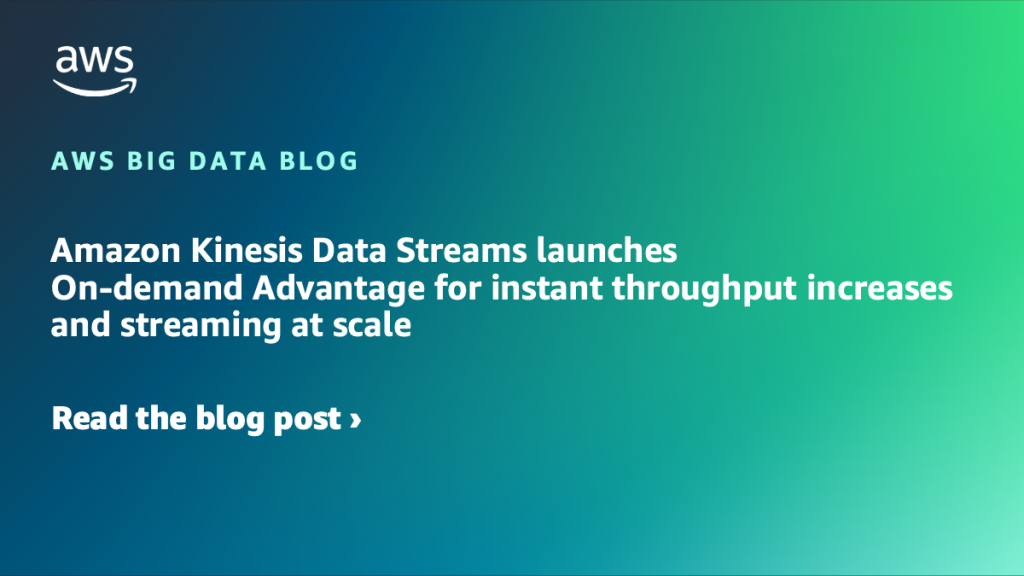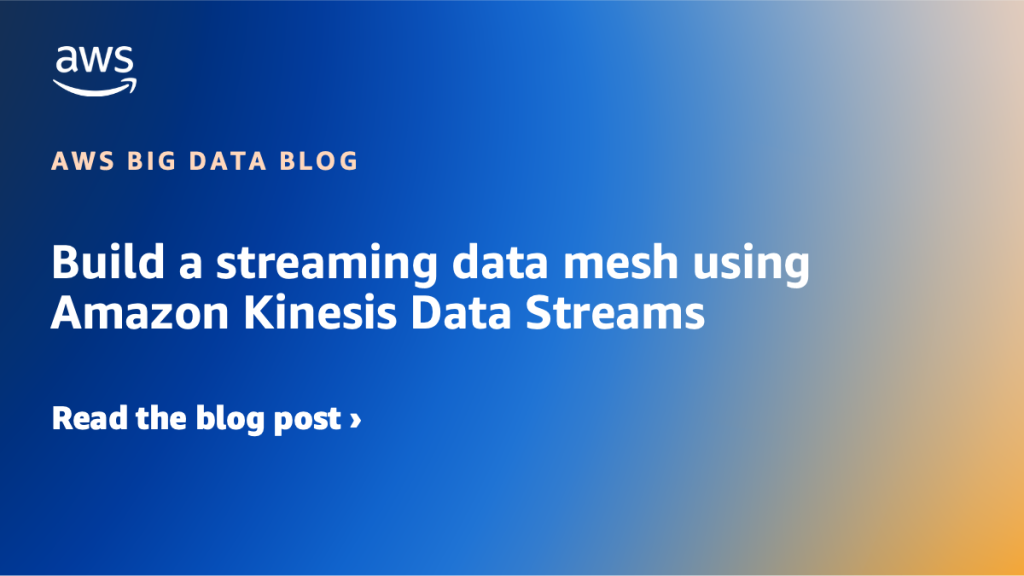AWS Big Data Blog
Category: Kinesis Data Streams
Amazon Kinesis Data Streams launches On-demand Advantage for instant throughput increases and streaming at scale
Today, AWS announced the new Amazon Kinesis Data Streams On-demand Advantage mode, which includes warm throughput capability and an updated pricing structure. With this feature you can enable instant scaling for traffic surges while optimizing costs for consistent streaming workloads. In this post, we explore this new feature, including key use cases, configuration options, pricing considerations, and best practices for optimal performance.
Amazon Kinesis Data Streams now supports 10x larger record sizes: Simplifying real-time data processing
Today, AWS announced that Amazon Kinesis Data Streams now supports record sizes up to 10MiB – a tenfold increase from the previous limit. In this post, we explore Amazon Kinesis Data Streams large record support, including key use cases, configuration of maximum record sizes, throttling considerations, and best practices for optimal performance.
Build a streaming data mesh using Amazon Kinesis Data Streams
AWS provides two primary solutions for streaming ingestion and storage: Amazon Managed Streaming for Apache Kafka (Amazon MSK) or Amazon Kinesis Data Streams. These services are key to building a streaming mesh on AWS. In this post, we explore how to build a streaming mesh using Kinesis Data Streams.
How Airties achieved scalability and cost-efficiency by moving from Kafka to Amazon Kinesis Data Streams
Airties is a wireless networking company that provides AI-driven solutions for enhancing home connectivity. This post explores the strategies the Airties team employed during their migration from Apache Kafka to Amazon Kinesis Data Streams, the challenges they overcame, and how they achieved a more efficient, scalable, and maintenance-free streaming infrastructure.
Deploy real-time analytics with StarTree for managed Apache Pinot on AWS
In this post, we introduce StarTree as a managed solution on AWS for teams seeking the advantages of Pinot. We highlight the key distinctions between open-source Pinot and StarTree, and provide valuable insights for organizations considering a more streamlined approach to their real-time analytics infrastructure.
Governing streaming data in Amazon DataZone with the Data Solutions Framework on AWS
In this post, we explore how AWS customers can extend Amazon DataZone to support streaming data such as Amazon Managed Streaming for Apache Kafka (Amazon MSK) topics. Developers and DevOps managers can use Amazon MSK, a popular streaming data service, to run Kafka applications and Kafka Connect connectors on AWS without becoming experts in operating it.
Introducing the new Amazon Kinesis source connector for Apache Flink
On November 11, 2024, the Apache Flink community released a new version of AWS services connectors, an AWS open source contribution. This new release, version 5.0.0, introduces a new source connector to read data from Amazon Kinesis Data Streams. In this post, we explain how the new features of this connector can improve performance and reliability of your Apache Flink application.
Top 6 game changers from AWS that redefine streaming data
Recently, AWS introduced over 50 new capabilities across its streaming services, significantly enhancing performance, scale, and cost-efficiency. Some of these innovations have tripled performance, provided 20 times faster scaling, and reduced failure recovery times by up to 90%. We have made it nearly effortless for customers to bring real-time context to AI applications and lakehouses. In this post, we discuss the top six game changers that will redefine AWS streaming data.
Use Amazon Kinesis Data Streams to deliver real-time data to Amazon OpenSearch Service domains with Amazon OpenSearch Ingestion
In this post, we show how to use Amazon Kinesis Data Streams to buffer and aggregate real-time streaming data for delivery into Amazon OpenSearch Service domains and collections using Amazon OpenSearch Ingestion. You can use this approach for a variety of use cases, from real-time log analytics to integrating application messaging data for real-time search. In this post, we focus on the use case for centralizing log aggregation for an organization that has a compliance need to archive and retain its log data.
Reduce your compute costs for stream processing applications with Kinesis Client Library 3.0
We are excited to launch Kinesis Client Library 3.0, which enables you to reduce your stream processing cost by up to 33% compared to previous KCL versions. KCL 3.0 achieves this with a new load balancing algorithm that continuously monitors the resource utilization of workers and redistributes the load evenly to all workers. In this post, we discuss load balancing challenges in stream processing using a sample workload, demonstrating how uneven load distribution across workers increases processing costs.









